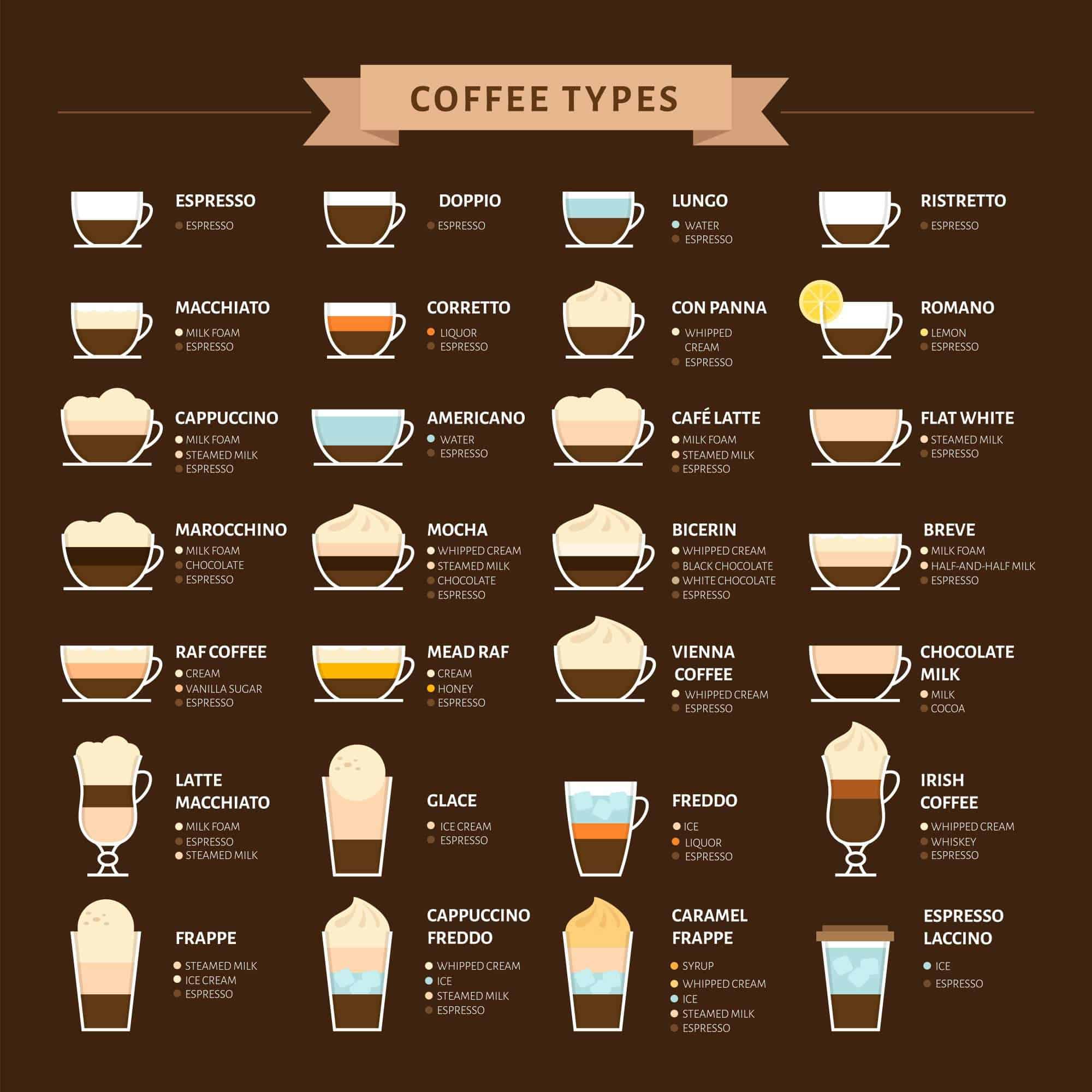
Broadly speaking, there are two main ways of making coffee, brewing methods (including drip coffee, French press and so on) and the espresso method.
Many of the familiar drinks on the menus of coffee shops around the world begin with a basic espresso and build from there.
Have you ever wondered which drinks are espresso-based? Or perhaps you’re not sure about the differences between some of the more obscure offerings.
If you’ve ever been perplexed by puzzles such as these, please read on and we will provide the answers you’re looking for.
Table of Contents
1. Espresso
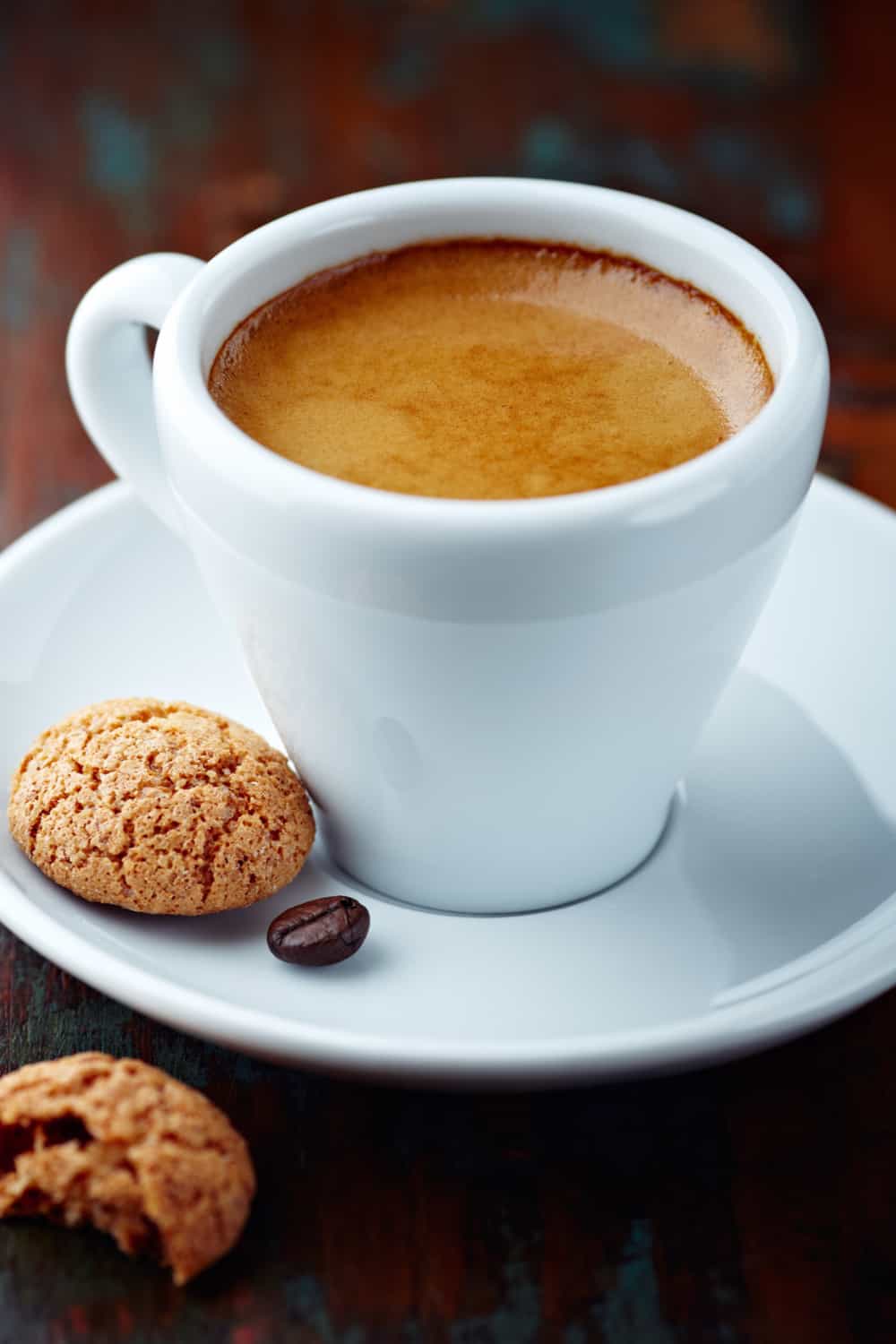
For some purists, espresso is the king of coffees and the only true way to drink the stuff. The espresso is where it all starts: without espresso, none of the other drinks on this list would be possible.
Espresso is made by forcing pressurized hot water at a temperature of about 19 0-200°F (88-93°C) through a small amount of finely ground beans. The result is a thick, rich and intense shot of coffee with a golden “crema” on top.
Many people believe espresso has a higher caffeine content than other coffees. This is true if you are measuring by volume – but there is a higher dose of caffeine in a regular cup of drip coffee or coffee made with a French press since there is simply more of it.
There are many factors to consider when making espresso, including beans, grind, amount of coffee, time, temperature and pressure.
2. Doppio
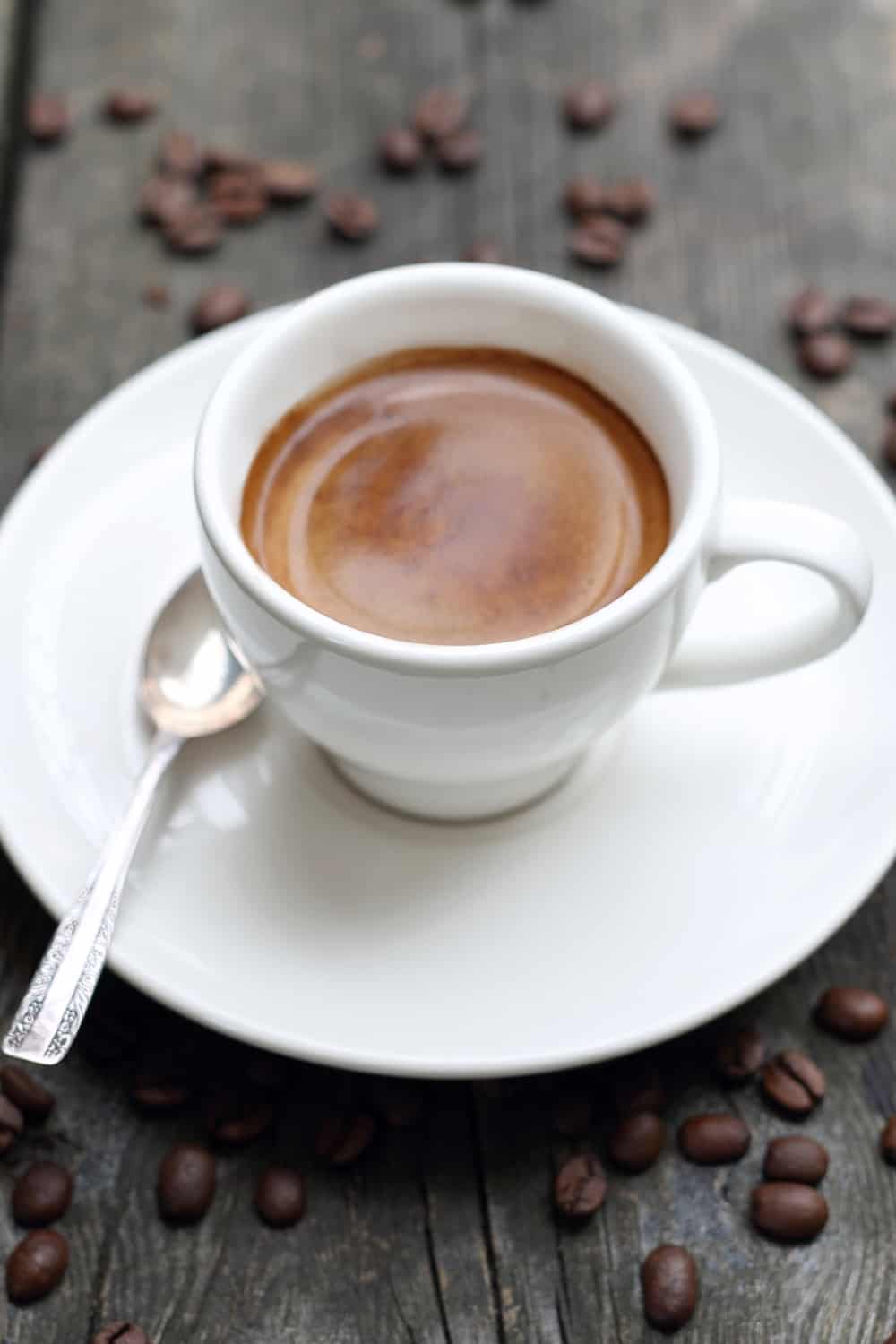
On some menus, you may see the word “doppio”, which is just Italian for double. A doppio is simply a double espresso, two regular espressos in one cup.
A doppio should definitely not mean the barista just allows more water to pass into the cup when pulling the espresso, this will only result in a more diluted drink (see “lungo” below) and not a true “doppio”.
Sometimes you may see “doppio” with other espresso drinks – this means the drink you are ordering is a double-strength version with two espresso shots in it instead of just one.
3. Ristretto
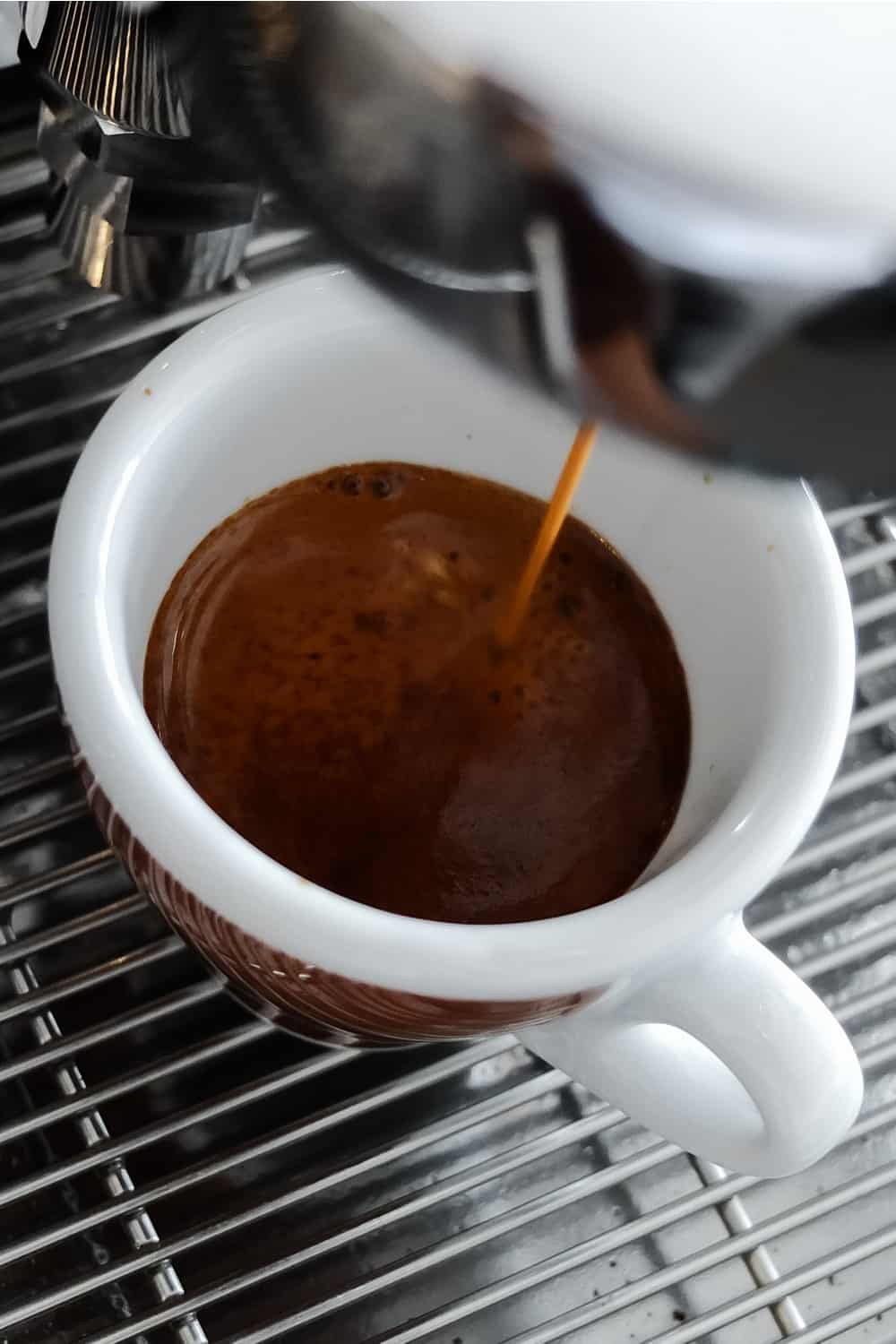
When serving a standard espresso, most of the coffee is extracted in the first moments, after which the liquid coming out becomes progressively more diluted. Part of the art of pulling a perfect espresso means knowing how long to wait before stopping the flow.
As mentioned above, if the barista allows the water to keep flowing too long, the espresso will become too diluted. On the other hand, if the barista stops sooner, the coffee will be even thicker and more intense than a standard espresso: this is a ristretto, a stronger, more concentrated espresso.
If you want the shortest, blackest, strongest shot of coffee available, ask for a ristretto – but don’t be surprised if you don’t find very much coffee in your cup.
4. Americano
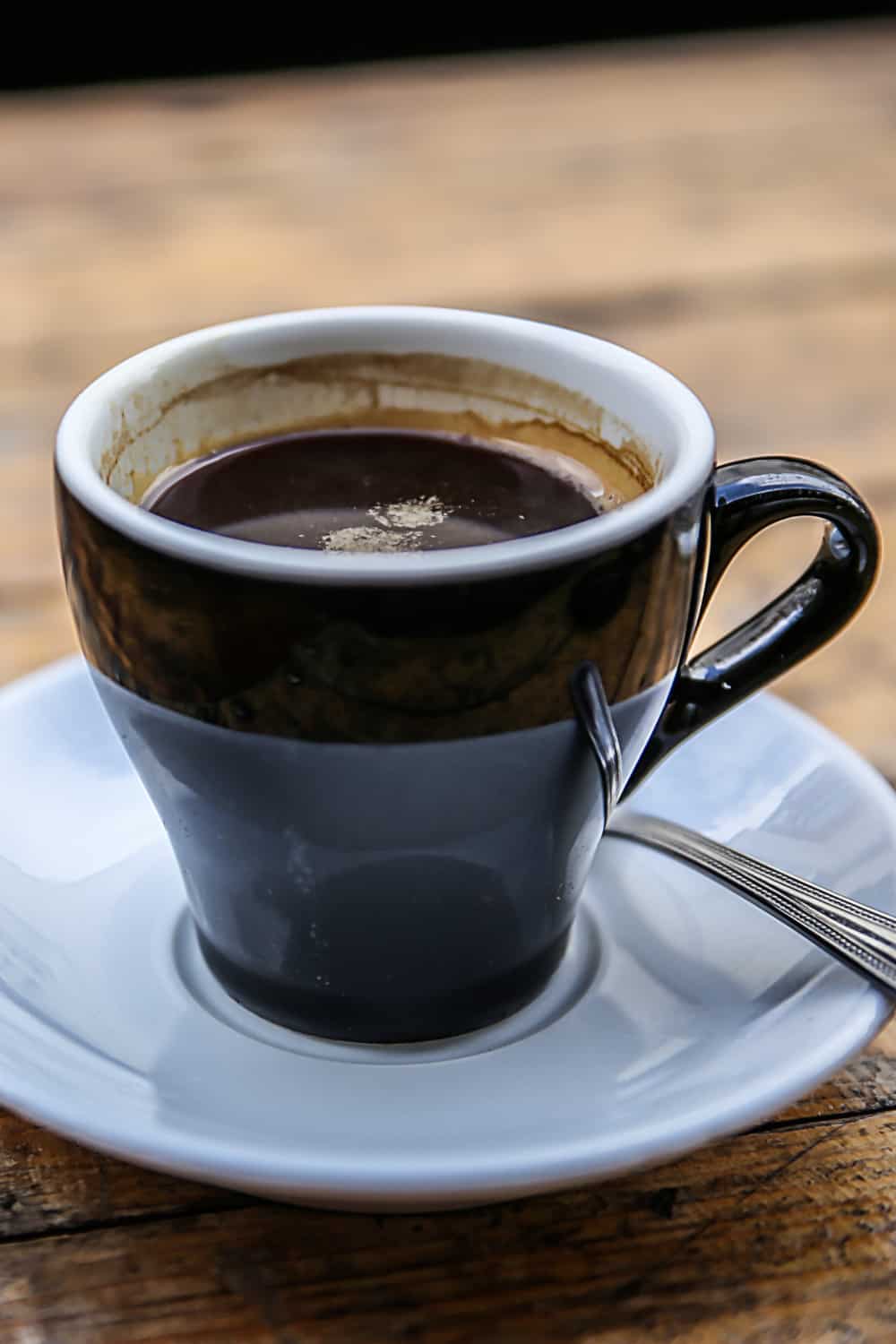
As the legend goes, the Americano was created during the Second World War when American soldiers were sent to fight in Europe. When soldiers in Italy ordered a coffee, they expected something like back home, but instead, they were served espressos, not what they wanted at all.
Using what was available, the local baristas took their espressos and added hot water to make a long drink more suited to the G.I.s’ tastes. The Americano was born.
The Americano is sometimes somewhat derided. Why would you want to water down the delicious intensity of an espresso? But if you’re in the mood for something that lasts a bit longer than a 1oz shot and you don’t want a milky concoction like a latte or cappuccino, an Americano could be the one to go for.
5. Long black and lungo
These two drinks are essentially alternative ways of making a longer drink from espresso, similar to the Americano concept.
While the Americano is made by adding hot water to dilute an espresso, the long black is made the other way around. First, the hot water is placed in the mug and the espresso is added after.
You might well imagine that that’s just the same drink. However, the long black method is supposed to preserve the crema while the Americano method intentionally dissipates it.
A lungo is slightly different but the result is the more or less the same: a long, black coffee. With a lungo, you use an espresso machine and begin by pulling a normal espresso shot – but then you continue to let the water flow from the machine, diluting the espresso and filling the cup.
Since the lungo is extracted for longer, it results in a more bitter drink than using the Americano or long black methods.
6. Cappuccino
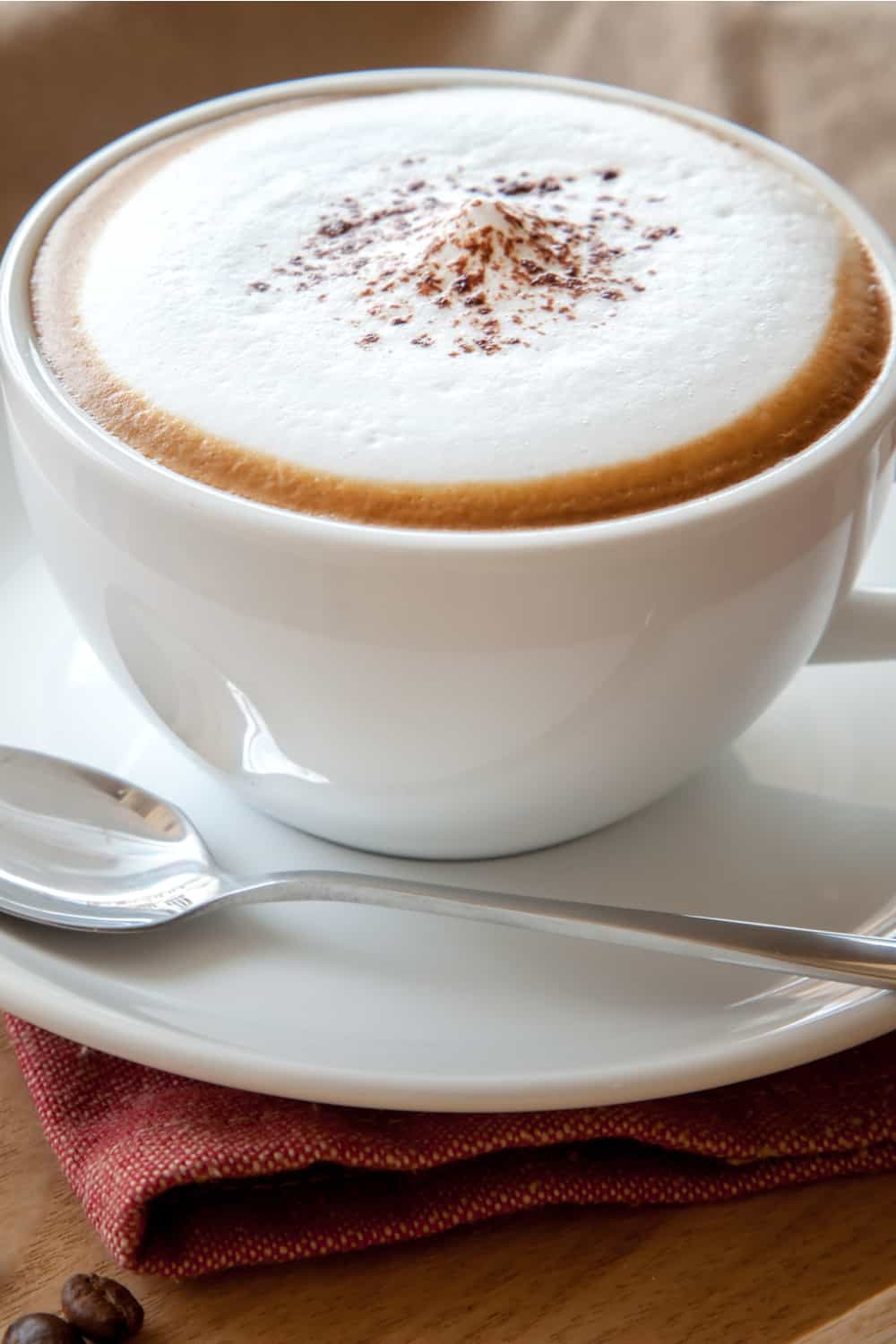
The cappuccino is one of the all-time classic espresso-based drinks. The modern cappuccino comes from Italy, where it is commonly enjoyed with breakfast. In the land of its birth, it is unusual – and considered slightly strange – to order one after about 11 am.
A cappuccino is made by first pulling an espresso shot (or a double) into a round cup. The barista then uses the steam wand on the espresso machine to heat a jug of milk, which separates into the froth and heated milk.
This mixture is poured onto the espresso shot, creating a milky coffee drink topped by a layer of froth. The ratio of espresso to milk to froth should be about 1:1:1. Skilled baristas often decorate cappuccinos with elaborate patterns in the froth, now known as “latte art”.
7. Latte
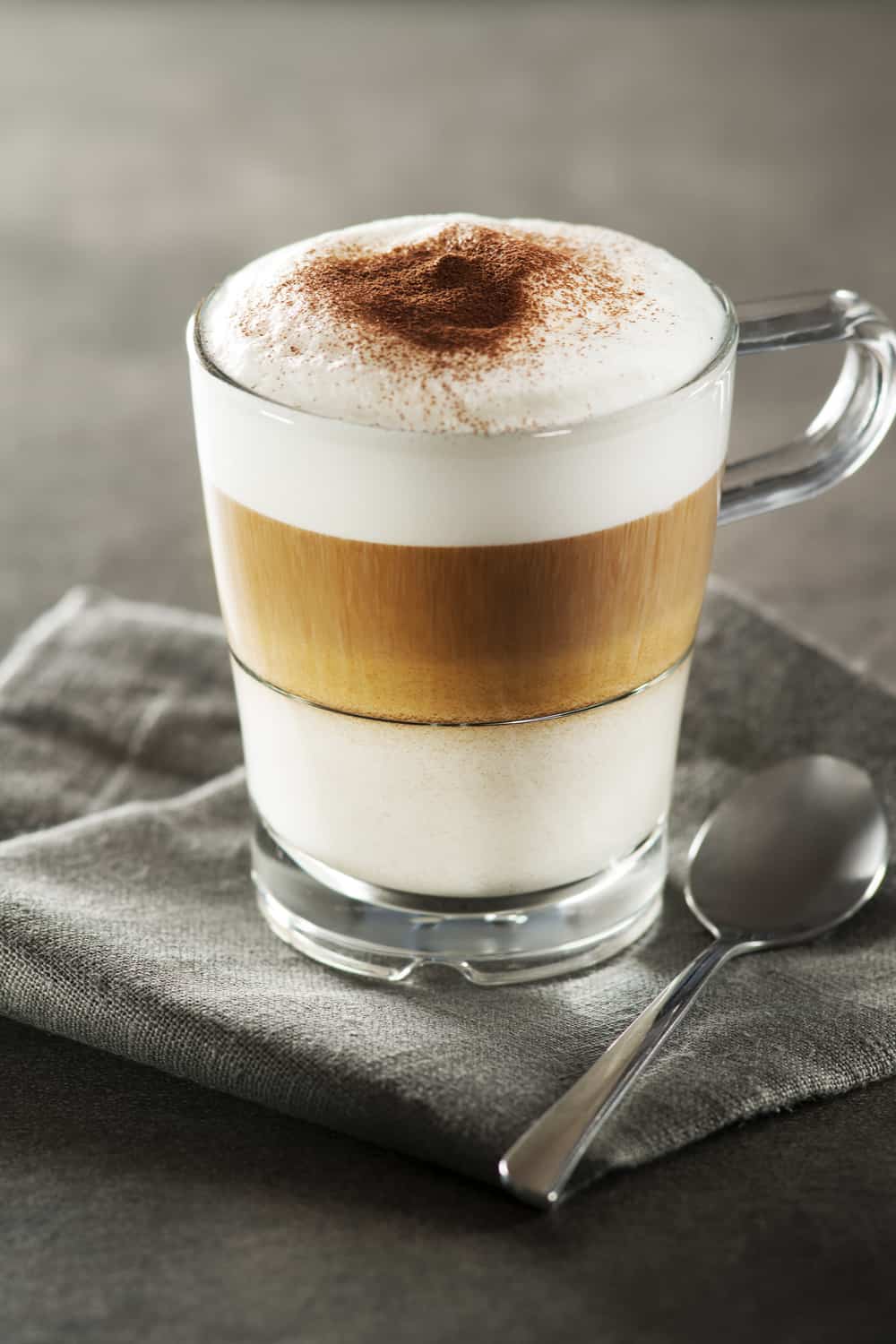
The latte has become one of the most popular espresso-based drinks all around the world, largely due to the influence of chains like Starbucks and the like.
Some people may be confused about the difference between a cappuccino and a latte since they are made in a fairly similar way – but they are quite distinct.
As with cappuccinos, lattes are made by adding steamed milk to an espresso shot. However, the difference lies in the ratios. With a latte, there is much more milk compared to the espresso, and the layer of foam on the top is much thinner than with a cappuccino.
Lattes are often served in tall glasses, although sometimes they may be presented in a cappuccino-style cup. Baristas often decorate lattes with latte art, hence the name of this practice.
Caffè latte in Italian literally means “milk coffee”. If you just ask for a latte in a bar in Italy, you will probably be served a glass of hot milk!
8. Flat White
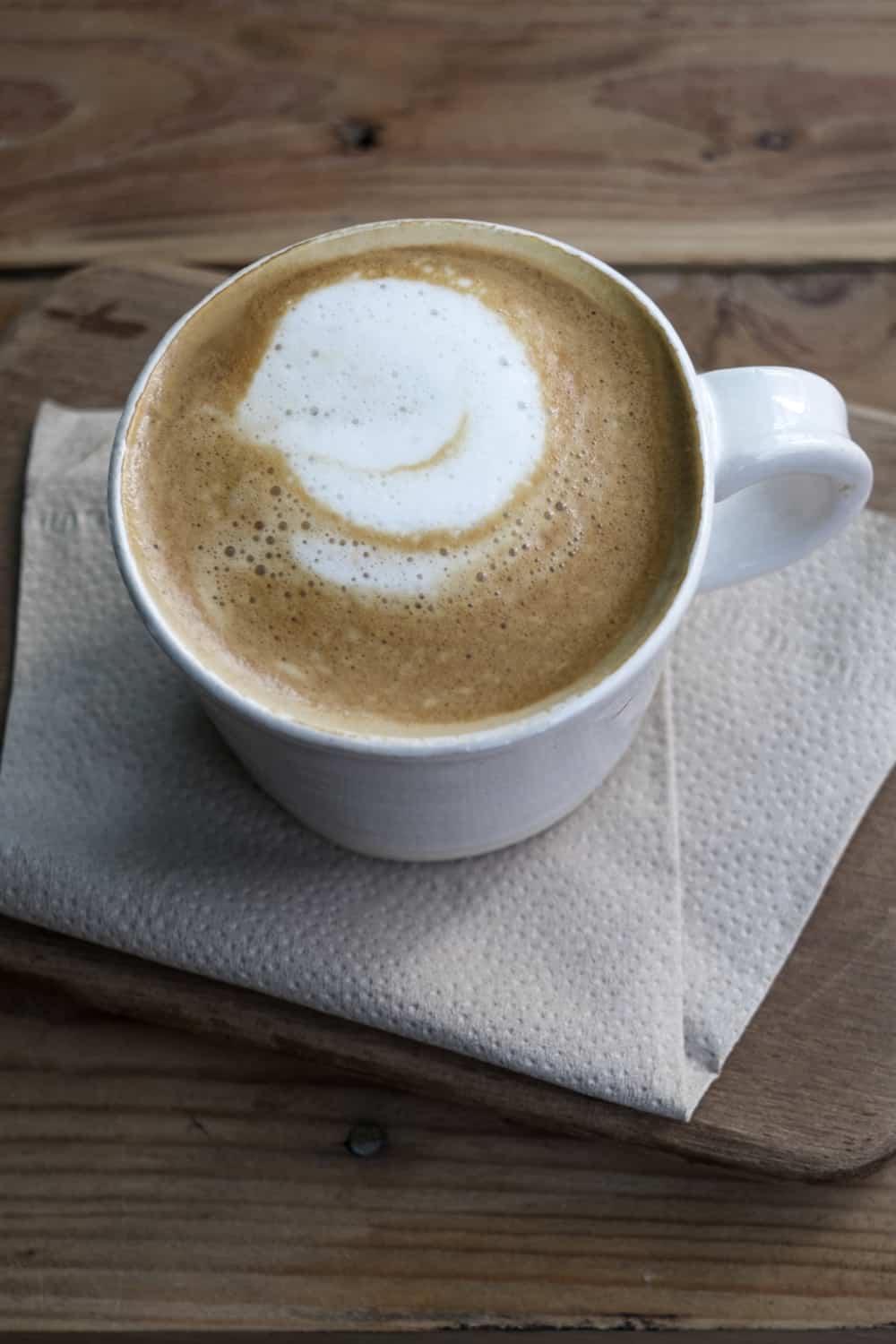
Although it has been a popular drink in Australia and New Zealand for many decades, the flat white has recently burst onto the international coffee scene, rapidly establishing itself as the coffee of choice for hipsters the world over.
If you’re still struggling to understand the difference between a cappuccino and a latte, the flat white is only going to confuse you even more. Some might consider it something like a hybrid of the two, others will simply dismiss it as a “small latte”. However, it’s neither of these. It’s something entirely different. Maybe.
As with cappuccinos and lattes, flat whites are made by adding steamed milk to an espresso shot. The difference here is that the milk is not separated into milk and froth; rather, the whole volume of milk should be in the form of microfoam.
This means when the milk is poured into the espresso, it combines completely with the coffee, leaving no layer of foam on top. Since flat whites are usually made with a double shot of espresso and a lower volume of milk than lattes or cappuccinos, the resulting drink is less milky and with a stronger espresso flavor.
9. Mocha
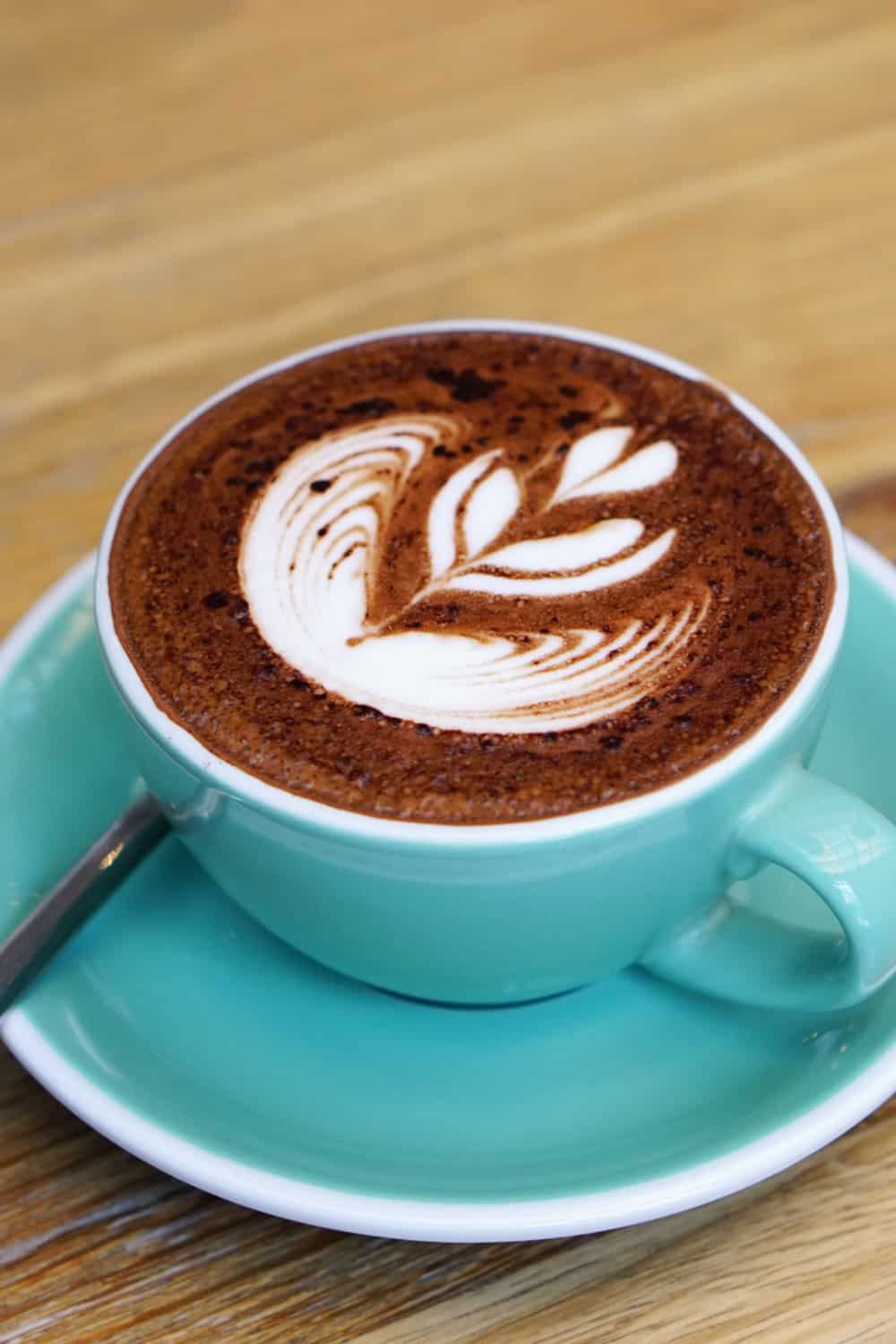
Depending on how you see things, a mocha is either a luxurious, indulgent treat for when you want to spoil yourself or alternatively, it’s a coffee drink for people who don’t really like coffee.
In its most basic form, a mocha is nothing more than a hot chocolate with a shot of espresso thrown in. However, most coffee shops will give you something much more elaborate more along the lines of a latte with chocolate inside and maybe cream on top.
The chocolate itself can be in the form of hot chocolate powder or real melted chocolate. The chocolate used is usually milk chocolate, but white or dark chocolate can be used instead.
Be careful not to confuse mocha the espresso drink with mocha (a type of coffee bean), Mocha (the place in Yemen where mocha beans come from) or moka (same pronunciation), the traditional pot that is especially popular for making coffee in Italy and Spain.
10. Macchiato
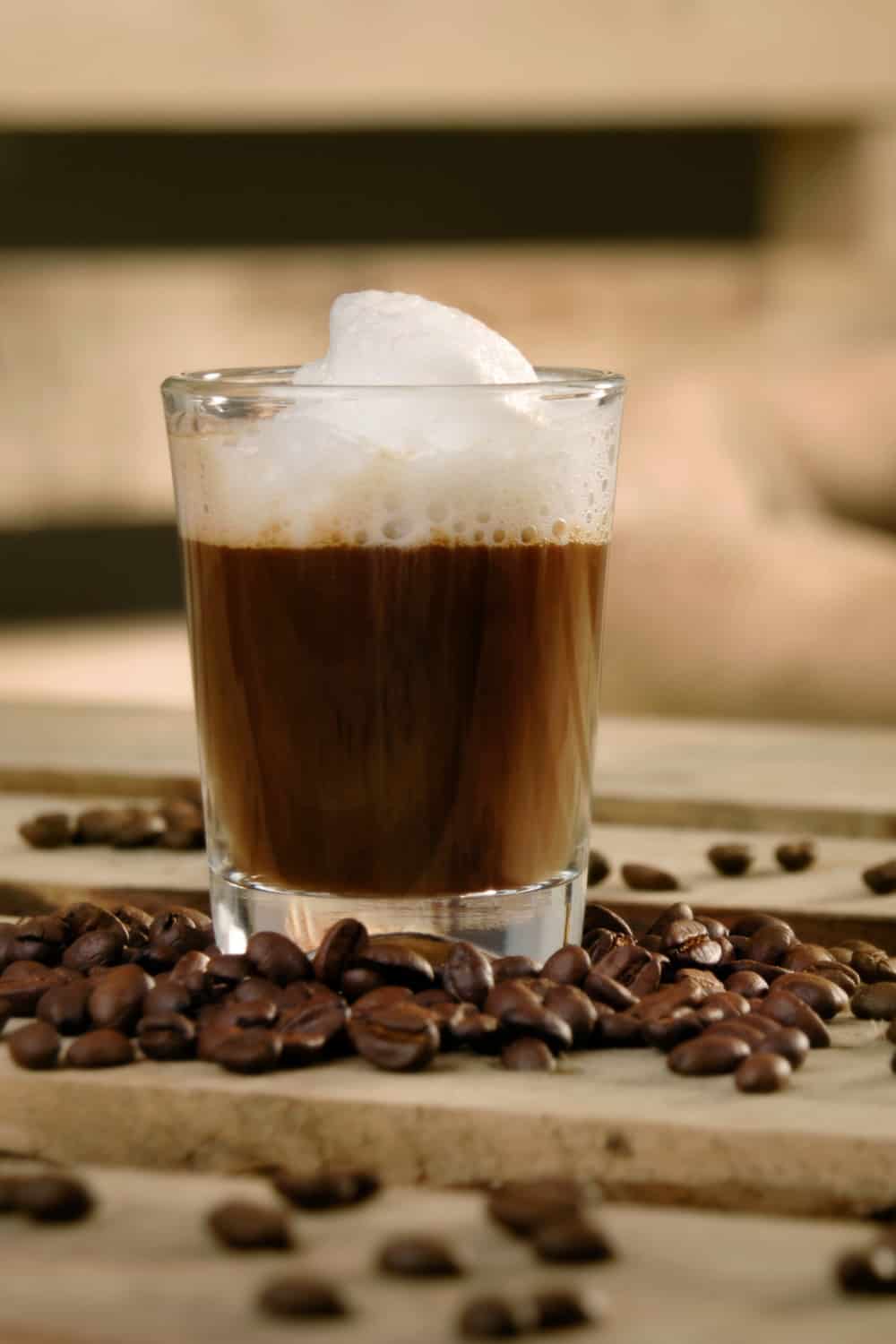
There is some contention over the precise definition of a macchiato so let’s clear things up right now. Macchiato in Italian means “marked” or “stained” and a caffè macchiato is simply an espresso “marked” with a dash of milk.
However, certain coffee shops, including some large and well-known chains, seem to have misappropriated this name, evidently reasoning that giving a coffee drink an Italian-sounding name will make it sell better.
You will now find all manner of beverages being served under this moniker. Sometimes macchiatos are “marked” with a dollop of foam – which is not so far from the authentic drink – and other times you will come across drinks sharing nothing with the original beyond the name.
It’s not a macchiato just because you call it one…
11. Cortado
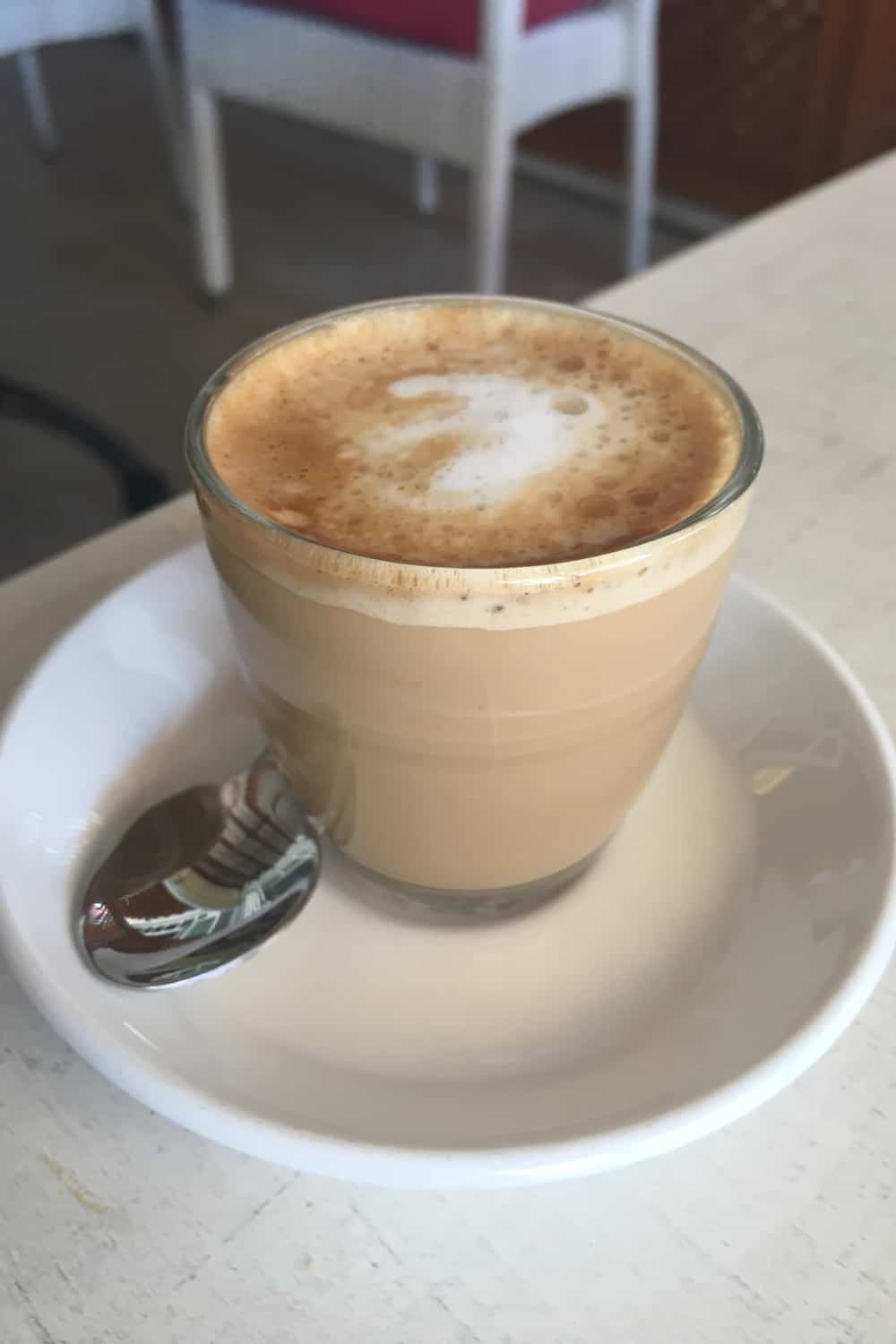
Something you may come across on some of the more specialist (or pretentious?) coffee menus is the cortado, a drink that can baffle all but the most knowledgeable and dedicated coffee connoisseurs.
Cortado is a Spanish word that is used in that country to describe a popular way of drinking espresso mixed with about an equal amount of milk. A true cortado should be a short drink served in a small glass.
If you order a “cortado” from a menu in North America, you will be served some version of an espresso with milk, although you might be best off checking with the barista to see what he or she considers the drink to be.
Usually, a cortado will differ from cappuccinos, lattes and the like in that there will be no foam on top and the drink will be somewhat shorter.
A cortado could be similar to a true Italian macchiato or a café au lait (“coffee with milk” in French). Again, giving drinks fancy foreign-sounding names doesn’t actually make them taste better.
12. Corretto
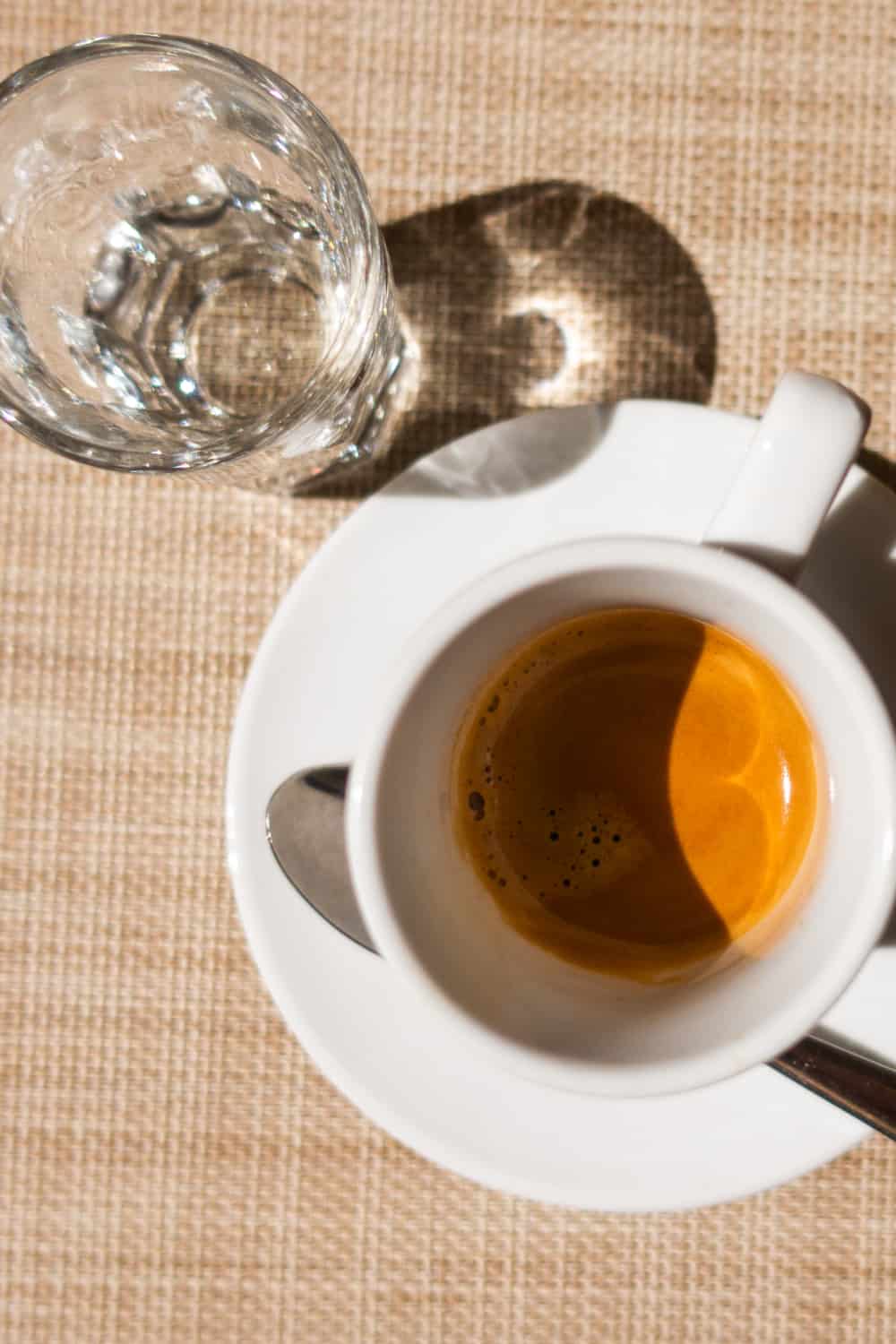
This is not a drink you are likely to find in your local Starbucks, but if you are eating in a decent authentic Italian restaurant, you may be able to try a traditional “corretto” at the end of your meal.
Corretto in Italian means “corrected”, and this refers to the fact that the espresso shot has been “corrected” with a shot of strong alcohol, most traditionally Italian grappa (although you are free to “correct” your coffee with the liquor of your choosing. Brandy is also popular.
13. Cubano
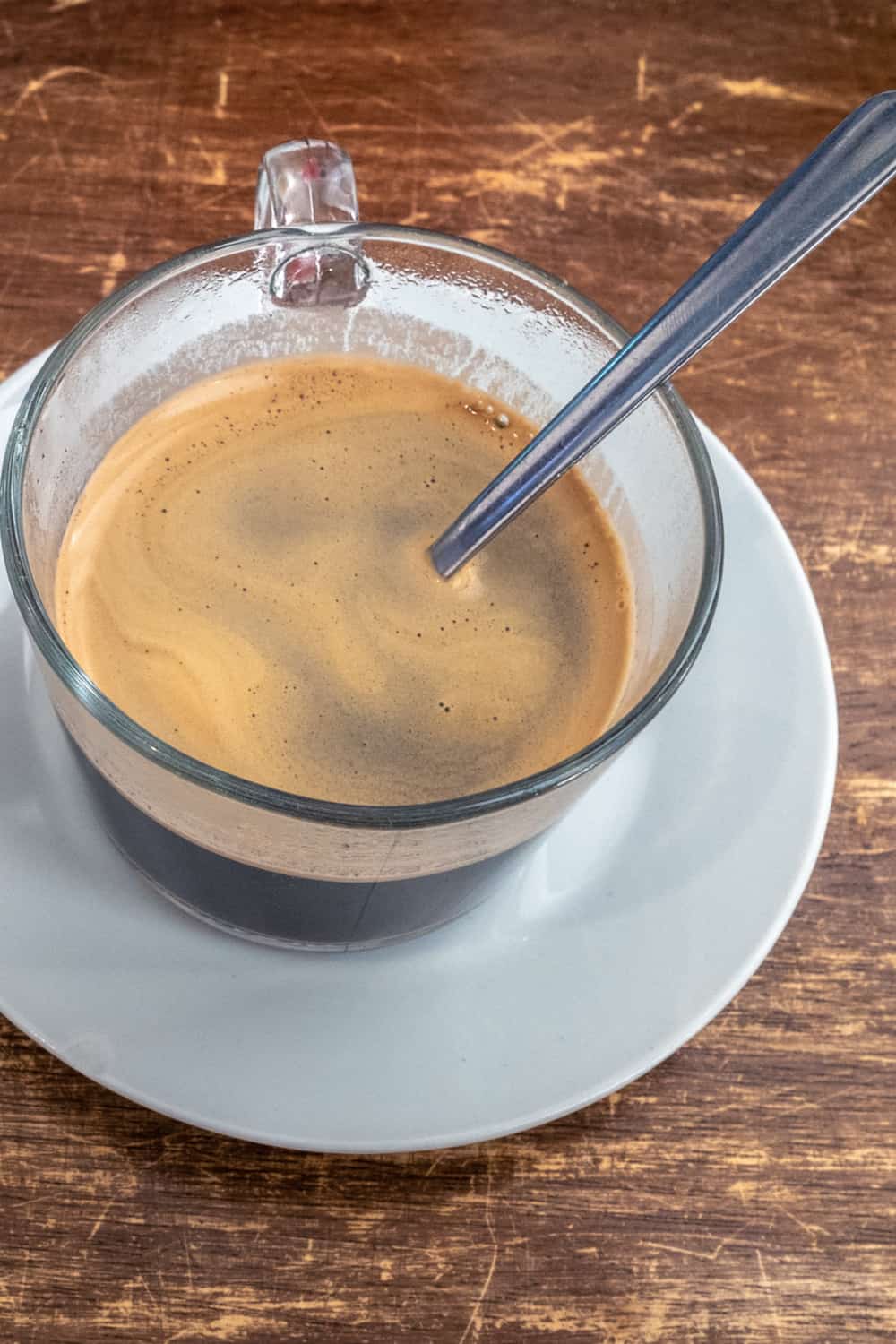
In Cuba, the coffee drink that takes its name from the country is served after practically every meal. The drink itself is an espresso-style coffee with a specific method of preparation, namely that demerara sugar is incorporated into the coffee while it is being prepared.
This results in a strong, dark, sweet coffee that is much-loved all over the island. The best place to drink a café Cubano is doubtlessly in Havana, but that’s not necessarily so practical for everyone.
Many coffee shops outside of Cuba (including Starbucks) offer Cubanos, so you don’t need to make the trip there just to try one – but of course, there’s no guaranteeing how authentic your cup will be outside of the country.
So much choice – so go and try!
So hopefully we’ve cleared a few things up for you. There are many ways to make coffee and many of the most popular drinks come from espresso. Some of them you probably know, others are perhaps less familiar. At least maybe now you have some new ideas about different coffees you can try.
Which are your favorite espresso-based drinks? What do you usually drink at the coffee shop? And how about at home? Do you have any special creations of your own? Please leave us a comment as we love hearing from you – and if you enjoyed our article, please don’t forget to share!
Nice Writing for the coffee listing.
Hello
Great list.
Good stuff. I really like it.
my favorite drink is latte macchiato. I love it. Thanks for such a helpful article.
Fantastic article thanks for sharing
I want to say thanks luckybelly. you are doing such a great work to provideing the best knowledge about espresso drinks. i have reads many others article with others site but your information is really appriciated thanks for sharing.